Download PDF
Solid Enterprise Planning, Scheduling, and Compliance Management

Technology Category
- Functional Applications - Enterprise Asset Management Systems (EAM)
Applicable Industries
- Cement
Applicable Functions
- Maintenance
Use Cases
- Asset Lifecycle Management
The Challenge
Ash Grove Cement would like to find a solution in automate maintenance data collection at each facility for a well-defined enterprise asset management process to support equipment performance reliability.
The Customer
Ash Grove Cement Company
About The Customer
Ash Grove Cement Company is a cement manufacturer based in Overland Park, Kansas, United States. It is the sixth largest cement manufacturer in North America, and the largest US-owned cement company.
The Solution
Avantis provides the solution which improves the availability and utilization balance of production assets and develops a standardized solution for each of its nine separate production facilities,while maintaining production.
Data Collected
Maintenance Records, Temperature, Parts and material pricing, Reorder activities
Operational Impact
Quantitative Benefit
Related Case Studies.

Case Study
System 800xA at Indian Cement Plants
Chettinad Cement recognized that further efficiencies could be achieved in its cement manufacturing process. It looked to investing in comprehensive operational and control technologies to manage and derive productivity and energy efficiency gains from the assets on Line 2, their second plant in India.

Case Study
Digital Transformation of Atlanta Grout & Tile: An IoT Case Study
Atlanta Grout & Tile, a Tile, Stone & Grout restoration company based in Woodstock, Georgia, was facing challenges with its traditional business model. Despite steady growth over the years, the company was falling behind the web revolution and missing out on the opportunity to tap into a new consumer base. They were using independent software from different vendors for each of their department information and workforce management. This resulted in a lot of manual work on excel and the need to export/import data between different systems. This not only increased overhead costs but also slowed down their response to clients. The company also had to prepare numerous reports manually and lacked access to customer trends for effective business decision-making.

Case Study
Revolutionizing Construction Equipment Rental: A Case Study on ProsRent and ENO8
ProsRent, a startup that won the 'Best Financial Opportunity' and 'Best Pitch' at CodeLaunch 2016, aimed to revolutionize the way construction professionals source and rent heavy equipment. In the construction industry, project managers and contractors typically rent heavy equipment from supply companies. However, predicting inventory can be challenging, and finding the required equipment at the right time and place can be a hassle. If the preferred vendor doesn't have the required equipment, it results in wasted time and money in searching for it, often leading to higher costs due to non-preferred rates and increased delivery costs if the vendor is located far from the job site. Suppliers, on the other hand, desired access to a wider base of trusted renters that they didn't have to vet themselves and wanted to offer dynamic rental pricing based on demand and availability in their market. ProsRent's challenge was to produce a minimum viable product that was fast and first to market but also strong enough to engender loyalty and repeat business from the target market.

Case Study
IoT Solution Enhances Comfort and Energy Efficiency at Apple Valley Commons Office
Apple Valley Commons, a mixed-use office complex built in 1986, was facing significant comfort and energy efficiency challenges. The building, which houses a variety of businesses, was experiencing extreme temperature imbalances, causing discomfort to employees and clients. Despite outdoor temperatures being consistently high during summers, occupants had to use space heaters to keep warm. The electricity bills from the constant operation of the heat pump were exorbitant. The building's elevator room on the roof was also overheating, reaching temperatures of 130 to 140 degrees, causing the elevator equipment to shut down. The building's existing controls solution did not provide a front end for diagnostics or remote control. The building management was seeking a solution that could address these temperature issues, improve occupant comfort, reduce operational costs, and increase building visibility.

Case Study
Revamping EE's Legacy ERP: A Case Study on BT's Strategic Transformation
EE, even after its merger with BT, was operating its ERP estate on legacy infrastructure, hosted on the premises of a third-party supplier. This outdated system resulted in a volume-based operational model, higher time to market, longer delivery cycles, and unsatisfactory customer experience. BT recognized the need for a strategic transformation of these aging ERP systems and sought a partner who could proactively manage application services. The partner was also expected to handle development requirements associated with application management services, drive accountability, and ownership with a time and target-driven transformation of these services. BT's primary goals were to improve customer experience, reduce cycle time, and measure these improvements with precision.

Case Study
AI-based Automation for Commercial Office HVAC: A Verdigris Case Study
Modern buildings are required to run longer hours, support a variety of end uses, and contribute to higher levels of economic productivity, leaving a thin margin for error. However, even the most advanced building and environmental control systems have failed to adequately support facilities and operations management. Buildings are often inefficient and the people using them are underserved. To meet occupant comfort and maintain cost and energy efficiency, a dynamic, AI-assisted approach is needed.




